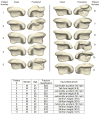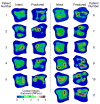Patient-specific finite element analysis of chronic contact stress exposure after intraarticular fracture of the tibial plafond
- PMID: 18404662
- PMCID: PMC2562934
- DOI: 10.1002/jor.20642
Patient-specific finite element analysis of chronic contact stress exposure after intraarticular fracture of the tibial plafond
Abstract
The role of altered contact mechanics in the pathogenesis of posttraumatic osteoarthritis (PTOA) following intraarticular fracture remains poorly understood. One proposed etiology is that residual incongruities lead to altered joint contact stresses that, over time, predispose to PTOA. Prevailing joint contact stresses following surgical fracture reduction were quantified in this study using patient-specific contact finite element (FE) analysis. FE models were created for 11 ankle pairs from tibial plafond fracture patients. Both (reduced) fractured ankles and their intact contralaterals were modeled. A sequence of 13 loading instances was used to simulate the stance phase of gait. Contact stresses were summed across loadings in the simulation, weighted by resident time in the gait cycle. This chronic exposure measure, a metric of degeneration propensity, was then compared between intact and fractured ankle pairs. Intact ankles had lower peak contact stress exposures that were more uniform and centrally located. The series-average peak contact stress elevation for fractured ankles was 38% (p = 0.0015; peak elevation was 82%). Fractured ankles had less area with low contact stress exposure than intact ankles and a greater area with high exposure. Chronic contact stress overexposures (stresses exceeding a damage threshold) ranged from near zero to a high of 18 times the matched intact value. The patient-specific FE models represent substantial progress toward elucidating the relationship between altered contact stresses and the outcome of patients treated for intraarticular fractures.
Figures






References
-
- Buckwalter JA, Brown TD. Joint injury, repair, and remodeling: roles in post-traumatic osteoarthritis. Clin Orthop Relat Res. 2004;423:7–16. - PubMed
-
- Brown TD, Johnston RC, Saltzman CL, et al. Posttraumatic osteoarthritis: a first estimate of incidence, prevalence, and burden of disease. J Orthop Trauma. 2006;20:739–744. - PubMed
-
- Huber-Betzer H, Brown TD, Mattheck C. Some effects of global joint morphology on local stress aberrations near imprecisely reduced intra-articular fractures. J Biomech. 1990;23:811–822. - PubMed
-
- Newberry WN, Garcia JJ, Mackenzie CD, et al. Analysis of acute mechanical insult in an animal model of post-traumatic osteoarthrosis. J Biomech Eng. 1998;120:704–709. - PubMed
Publication types
MeSH terms
Grants and funding
LinkOut - more resources
Full Text Sources
Medical

